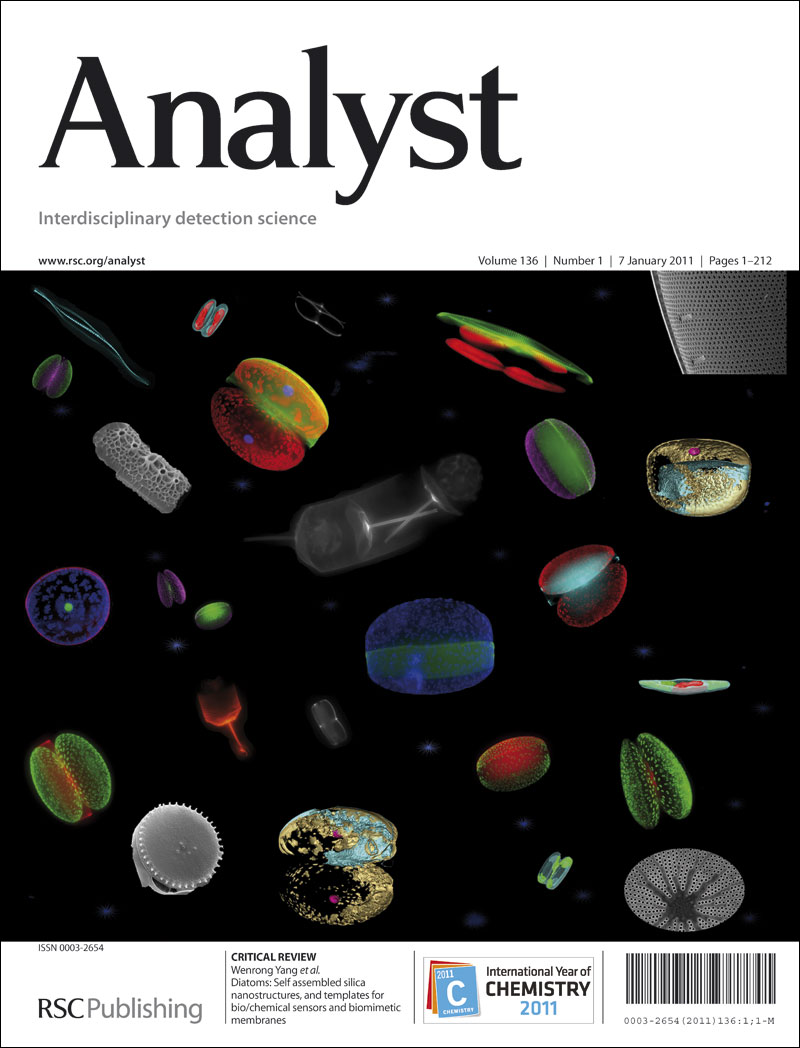Dye doped fluorescent polypyrrole nanotherapeutic probes as a versatile platform for ratiometric pH sensing-guided and self-monitored photothermal therapy of tumors
IF 3.6
3区 化学
Q2 CHEMISTRY, ANALYTICAL
引用次数: 0
Abstract
A multifunctional fluorescence polypyrrole nanotherapeutic probe (denoted as PPy@RhB-PAA-FITC) was constructed for pH sensing-guided photothermal therapy (PTT) of cancer and self-monitoring temperature variations during PTT. By using photothermal therapy materials polypyrrole (PPy) nanoparticles as a matrix, the temperature-responsive rhodamine B (RhB) and pH-sensitive fluorescein isothiocyanate (FITC) fluorescent dye were linked to the nanoparticles through encapsulation and electrostatic interaction, respectively. The fluorescent intensity of FITC increased dramatically with enhanced pH and little variation appeared in emission intensity of RhB, which was responsible for ratio fluorescent pH sensing performance. For pH detection, the nanoprobes exhibited a linearity in pH range from 4.54 to 6.4 with an acid dissociation constant (pKa) value of 5.80. PPy nanoparticles were in charge of PTT that endowed this nanotherapeutic system with 36.24% photothermal conversion efficiency. Meanwhile, the fluorescent intensity of RhB was decreased due to the increase of heat-induced temperature, which enabled to satisfy the need of self-monitoring temperature during PTT. The thermal sensitivity of 1.4%/°C were harvested in temperature-sensing assays. Moreover, by the combination of the ratio fluorescent pH imaging, the photothermal conversion and self-detection temperature, the PPy@RhB-PAA-FITC was successfully applied for pH-mediated tumor diagnosis and self-monitored treatment. The proposed PPy@RhB-PAA-FITC broadens the PPy-based nanomaterials applications in ratiometric fluorescent pH imaging and self-feedback temperature changes guided photothermal therapy.染料掺杂荧光聚吡咯纳米治疗探针作为比值pH传感引导和自我监测肿瘤光热治疗的通用平台
构建了一种多功能荧光聚吡啶纳米治疗探针(表示为PPy@RhB-PAA-FITC),用于pH感应引导癌症光热治疗(PTT)并自我监测PTT过程中的温度变化。以光热治疗材料聚吡咯(PPy)纳米颗粒为基体,通过包封和静电相互作用分别将温度响应型罗丹明B (RhB)和ph敏感型异硫氰酸荧光素(FITC)荧光染料与纳米颗粒连接。FITC的荧光强度随着pH值的增加而显著增加,而RhB的发射强度变化不大,这是比值荧光pH传感性能的原因。对于pH检测,纳米探针在4.54 ~ 6.4的pH范围内呈线性关系,酸解离常数(pKa)为5.80。PPy纳米粒子负责PTT,使该纳米治疗体系具有36.24%的光热转换效率。同时,由于热致温度的升高,RhB的荧光强度降低,能够满足PTT过程中自我监测温度的需要。在温度传感试验中获得了1.4%/°C的热敏度。此外,通过比值荧光pH成像、光热转换和自检测温度的结合,PPy@RhB-PAA-FITC成功应用于pH介导的肿瘤诊断和自我监测治疗。提出的PPy@RhB-PAA-FITC拓宽了基于pp的纳米材料在比例荧光pH成像和自反馈温度变化引导光热治疗中的应用。
本文章由计算机程序翻译,如有差异,请以英文原文为准。
求助全文
约1分钟内获得全文
求助全文
来源期刊

Analyst
化学-分析化学
CiteScore
7.80
自引率
4.80%
发文量
636
审稿时长
1.9 months
期刊介绍:
"Analyst" journal is the home of premier fundamental discoveries, inventions and applications in the analytical and bioanalytical sciences.
 求助内容:
求助内容: 应助结果提醒方式:
应助结果提醒方式:


